|
|
|
|
 
Zaō Gongen
Origin = Japan
With Hindu & Buddhist Antecedents
Who is Zaō Gongen?
Avatar Zaō of the Diamond Realm
Thunderbolt (Vajra) Holder
Mountain King, Diamond Avatar
Major Deity of Japan's Shugendō Sect
Protector Deity of Mt. Kimpu, Japan
Patron Deity of Mountain Ascetics
(Ascetics = Yamabushi 山伏 or Shugenja 修験者)
Click Here for Extended List of Popular Japanese Gongen
Zaō Gongen (also spelled Zao) is one of the most important mountain deities of Japan's syncretic Shugendō sects, a diverse tradition of mountain ascetic practices associated with Shintō beliefs, Taoism, magic, supernatural powers, and Esoteric (Tantric) Buddhism. After the arrival of Buddhism to Japan in the mid-6th century, the native Shintō kami (deities) were soon considered manifestations of the imported Buddhist divinities. Zao serves as the protector deity of sacred Mt. Kimpusen (Mt. Kinpu) 金峰山 in Japan's Nara prefecture and is considered the local Japanese Shintō manifestation (avatar = gongen 権現) of three Buddhist divinities -- the Historical Buddha, Kannon Bodhisattva, and Miroku Buddha, who serve respectively as the Buddhas of the Past, Present, and Future. This makes Zao perhaps the most powerful local divinity of religious mountain worship (Sangaku Shūkyō 山岳宗教) in Japan.
Zao is widely venerated in the entire mountain range stretching from Yoshino to Kumano (the cradle of Shugendō practice), but also venerated at numerous remote mountain shrines and temples throughout the country. Despite Zao's Tantric appearance, the deity is generally thought to be of Japanese origin (see caveats below). Zao's cult spread throughout Japan from the 11th century onward.
Attributes. Zao is generally depicted as a Tantric deity of the Esoteric (Vajrayana) tradition, with attributes similar to those of the Wrathful Deities (known as the Myo-o in Japan). Zao is typically blue-black in color, with hair standing on end and holding a thunderbolt (vajra) in right hand. The left hand (near the hip) forms the sword mudra (Jp. = tōken-in 刀剣印; also known as tō-in 刀印). This mudra (hand gesture) is also called Gundari-in 軍茶利印 and is associated with another wrathful deity named Gundari Myō-ō. It is one of various "wrathful" mudra aimed at conquering evil. Zao typically appears with grimacing face, three eyes, two arms, raised right foot, and wearing a lion-skin belt. There are variations, mind you, but Zao is nearly always characterized by enormous energy, vitality, and wrathful appearance -- not only to frighten disbelievers but also to symbolize Zao's vanquishing of evil thoughts and actions. Statues of Zao in Japan often show the deity engulfed in flame. This symbolizes the burning away of all desire, the consumption of all passion, and the vanquishing of evil.

|
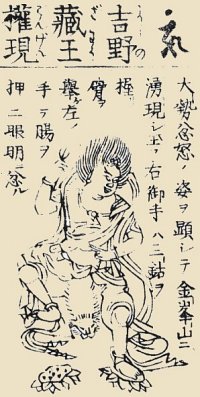
IMAGE COURTESY
Butsuzō-zu-i 仏像図彙
Collected Illustrations
of Buddhist Images
Published 1783. One of Japan's first major studies of Buddhist icons, with drawings by Tosa Hidenobu 土佐秀信 and text by Ito Takemi 伊藤武美. Hundreds of pages and drawings, with deities classified into some 80 (eighty) categories. Modern-day reprints are available for purchase at most large Japanese book stores. Click here to buy book.
Fragment, Kokugakuin University.
No date given. Photo courtesy:
LINK 1 | LINK 2
|
|
 What is Gongen? What is Gongen?
Gongen 権現 is a Japanese term meaning "avatar." Similar Japanese terms include Gonge 権化 and Kegen 化現, all referring to manifestations or reincarnated forms of Buddhist divinities who remain on earth to bring salvation to all sentient beings. More specifically, Gongen refers to local Shintō kami (deities) who are considered manifestations of the imported Buddhist divinities. Zaō Gongen is considered the Shintō and Shugendō manifestation of at least three Buddhist deities (see details below). By Japan's late Heian and early Kamakura period, the practice of naming shrines with the names of their gongen (avatars) became widespread.
However, when the Meiji government forcibly separated Shintō and Buddhism (Shinbutsu Bunri 神仏分離) in the late 19th century, it abolished the "gongen" naming convention, and shrines thereafter became known as "jinja." The Meiji government also actively promoted the term Daimyōjin 大明神 (Great Illuminator Deity) and demoted the earlier honorary title of Daigongen 大権現 (Great Avatar). This was considered one way for the government to promote Shintō supremacy over the imported Buddhist faith.
Shugendō ascetic practices were declared superstitious and banned by the Meiji government, dealing a severe blow to Shugendō practice. For more, see Short History of Shintō-Buddhist Syncretism below.

Zao Origin, Lore, and Legend
In Japan's Asuka Period (6th century AD), belief in Japan's indigenous religious tradition was given the name SHINTO to differentiate it from the imported Buddhist faith. Shintō in those days was predominantly based on mountain worship, shamanistic practices, age-old rituals, and festivals that differed widely among various localities. Shintō rites were already firmly established at the court, in particular the annual Niinamesai Festival 新嘗祭 when the emperor presented the year's first rice harvest to the local deities. Emperor Tenmu 天武 (+673 - 686) found it necessary to segregate Folk Shintō from Jinja (Shrine) Shintō during his reign to ensure state control over the oldest traditions and Shintō festivals.
Interestingly, Shintō deities were not given anthropomorphic characteristics until after the appearance of the Nihon Shoki 日本書紀 (Chronicles of Japan), one of Japan's earliest official records, disseminated around +720. Together with the Kojiki 古事記 (Record of Ancient Matters), another court-sponsored document of that time, these extensive histories were commissioned by Emperor Tenmu to demonstrate to the Chinese Emperor that the Yamato 大和 Dynasty (aka Japan) had a long and distinguished history -- thereby proving that Japan was a sovereign kingdom.
One of the most celebrated mountain sages in those formative years was En no Gyōja 役行者 (literally "En the Ascetic"). This legendary holy man was a mountain ascetic (yamabushi 山伏) of the late 7th century.
Like much about Shintō-Buddhist syncretism, his legend is riddled with folklore. He was a diviner at Mt. Katsuragi on the border between Nara and Osaka. Said to possess magical powers, he was expelled in +699 to Izu Prefecture for "misleading" the people and ignoring state restrictions on preaching among commoners. He is considered the father of Shugendō (Shugendo) 修験道, a major syncretic movement that combined pre-Buddhist mountain worship (sangaku shinkō 山岳信仰) with Buddhist, Shintō, and Taoist teachings. Popular lore says he climbed and consecrated numerous sacred mountains. Mountain ascetics today are called yamabushi 山伏 or shugenja 修験者.

 Various Names for Zao Gongen Various Names for Zao Gongen
蔵王権現 = Zaō Gongen, Avatar Zaō, Diamond Zao Avatar
金剛蔵王権現 = Kongō Zaō Gongen (Diamond Realm Zaō)
吉野蔵王権現 = Yoshino Zaō Gongen, Guards Yoshino area
金剛蔵王菩薩 = Kongō Zaō Bosatsu (Bodhisattva)
蔵王菩薩 = Zaō Bosatsu (Bodhisattva)
金剛明神 = Manifestation of Kongō Myōjin, Guards Japan’s Yoshino area
Literal Translations of Zao's Japanese Name
- 藏 = Za, also Zō = matrix, embryo, store, realm
- 王 = ō, also ou = king
- 金剛 = Kongō = Vajra (Skt.) = adamantine; diamond-like; indestructible
- 権現 = Gongen = Old Japanese term for local Shinto kami with Buddhist counterparts
- 明神 = Myōjin = Current Japanese term for local Shinto kami with Buddhist counterparts
Legends of Mt. Kinpu. According to legends from Kinpusenji Temple 金峯山寺 (a stronghold of Zaō worship) and elsewhere, En no Gyōja had visited Mt. Kimpu (Kinpu) and prayed for a tutelary deity to appear to him, one who could save all sentient beings and help him to subdue demons and evil. Three Buddhist divinities appeared: (1) Shakyamuni, the Historical Buddha, the Buddha of Past Ages; (2) 1000-Armed Kannon, the Savior in Current Age; and (3) Miroku, the Buddha of the Future. En no Gyōja prayed again, and the triad merged into one deity, the Avatar Zao Gongen, who endowed En no Gyōja with magical powers. This legend and others did not appear until the 12th-13th centuries, long after the death of En no Gyōja. There are many variations. In one story, the first deity who came forth looked like the gentle Jizo Bosatsu, but was rejected as too mild in appearance. Only later, after various deities had appeared, did the fierce form of Zao emerge and gain acceptance. Writes Kadoya Atsushi at Kokugakuin University: "Another version relates that Zaō appeared in the form of a mandala, sitting on a Jeweled Stone in the lake Seiryū at the peak of Mt. Kimpu. Another states that while En was meditating at Mt. Yūjutsu, the deity Benzaiten appeared on the seventh day, becoming known as the Tenkawa Benzaiten; on the fourteenth day a Jizō Bodhisattva appeared, and this became known as the Shōgun Jizō of Kawakami. Finally, on the twenty-first day Zaō appeared as the fierce deity Kōjin, incorporating the identities of the three Buddhas Dainichi, Shakyamuni, and Amida." <end quote>
|
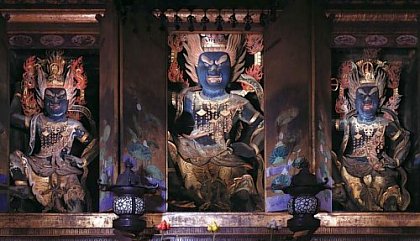
(L) Miroku (C) Historical Buddha (R) 1000-armed Kannon
Three “Hidden Buddha 秘仏” Statues of Zaō Gongen
at the Zaōdō 蔵王堂 (Zaō Hall), Kinpusenji Temple 金峯山寺
Wood (cherry). Central Image About Seven (7) Meters High.
National Treasures, National Important Cultural Properties.
Dated to Azuchi-Momoyama period, though unclear.
Photo courtesy of Kinpusen Temple's web site.
Says the temple’s website: 秘仏本尊・金剛蔵王権現・
本地仏の釈迦如来(過去世)・千手観音(現在世)・
弥勒菩薩(未来世)・権化・金剛蔵王とは、金剛界と胎蔵界を
統べるという意味も表しています
|
|


 Short History of Shinto / Buddhist Syncretism Short History of Shinto / Buddhist Syncretism
By the 7th century, the Japanese court had aggressively accepted Buddhism, not only as a religious vehicle promising salvation for the upper classes, but also as an instrument to consolidate state power. See Early Japanese Buddhism for details. Around the 8th century, Shinto traditions begin to imitate and blend with Buddhist influences. The Shinto-Buddhist syncretism of the period was actually formalized and pursued based on a theory called Honji Suijaku 本地垂迹. The process of blending Buddhism with Shinto progressed uninterrupted, and by the Heian Period (794-1185), Shinto deities came to be recognized as incarnations of Buddha deities. In the Shingon esoteric sect, for example, the Shinto sun goddess Amaterasu was identified with Mahavairocana (Dainichi Buddha). Another center of Shinto/Buddhist merging was the syncretic Tendai shrine-temple multiplex located at Mt. Hiei (Shiga Prefecture, near Kyoto), which came to prominence around the same time as Shingon Esoteric Buddhism. The Honji Suijaku theory was used in Japan to explain the relation between Shinto gods and Buddhas; the Buddhas were regarded as the honji 本地 (original deities) and the Shinto gods as their incarnations or suijaku 垂迹. Theoretically, honji and suijaku are an indivisible unity and there is no question of valuing one more highly than the other; but in the early Nara period, the honji was regarded as more important than the suijaku. Gradually they both came to be regarded as one; but in the Kamakura period, Shintoists also proposed the opposite theory, that the Shinto gods were the honji and the Buddha the suijaku. This theory was called han-honji-suijaku setsu or shinpon-butsuju setsu.
By the 9th century, Buddhist temples were constructed alongside Shinto shrines on many sacred mountains, epitomized by the holy Shugendō places throughout the Yoshino mountain range and by the powerful Tendai multiplex on Mt. Hiei. The native Shinto kami (deities) residing on these peaks were considered manifestations of Buddhist divinities, and pilgrimages to these sites were believed to bring double favor from both their Shinto and Buddhist counterparts. Another major center of syncretism was the Kasuga Shrine in Nara. The number of deities proliferated. Despite earlier resistance, syncretism was relatively smooth and marked by religious tolerance.
By the 11th and 12th centuries, the Zaō Cult was transmitted to the Kumano region and from there spread throughout Japan. It was a time of great syncretism, with Buddhist temples and Shinto shrines sharing not only the same space on many sacred mountains, but with both traditions sharing their deities as well. Over time, however, Zaō was eclipsed in popularity by Fudō Myō-ō, a major Tantric deity of Japan's Shingon and Tendai esoteric sects.

During the Meiji restoration, Shugendō practices were declared superstitious and banned by the Meiji government. However, since the modern era and the freedom of religion granted by Japan's postwar constitution, Shugendō has staged a comeback. Its main centers of practice today are on Mt. Ōmine 大峰山 near Nara (also called Mt. Sanjō; head temple Ōminesanji 大峰山寺) and on Mt. Kinpusen 金峯山 near Yoshino (head temple Kinpusenji 金峯山寺. Both temples are located near each other in the Yoshino-Kumano National Park in the Kansai area. The park area was designated a World Heritage Site by UNESCO in 2004. Shugendō is also practiced by the yamabushi of Dewa Sanzan (Tendai sect), the Shingon sects associated with Ishiyama-dera (near Kyoto), and among the shrine-temple multiplexes at Ishizuchiyama (Shikoku island) and at Mitokusan (Tottori prefecture).
Says site contributor Gabi Greve: “Three of the most famous mountain sites associated with Zao Gongen are in the Yoshino 吉野 area, at Ishizuchiyama 石鎚山 in Shikoku, and at Mitokusan Sanbutsuji Temple 三徳山三仏寺 in Tottori Prefecture. According to Japanese legend, one day the mountain ascetic En no Gyōja 円の行者 threw three lotus petals in the air and vowed to establish temples on the ground where they fell. One landed at Yoshino (near Nara), one landed at Ishizuchiyama (in Shikoku) and one among the Mitoku mountains in Tottori prefecture. That supposedly happened back in the year 706. This year 2006, on the third Sunday in October, a great celebration with a 1300-year tradition is held by the Mitoku shrine-temple mountain multiplex. The renewal of the famous Nage-ire Doo 投入堂 (tossed-in temple) is also celebrated. The construction of the hard-to-reach Nage-ire structure is almost impossible to explain. It is said En no Gyōja threw the structure up from below, hence its name. Mountain ascetics walk through the glowing embers on the day of celebration (also known as the Yamabushi Fire Walking Festival).” <end>

|
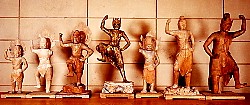
Various Zao Gongen Statues at Nage-ire Dō, Mitokusan.
All made of wood (cypress = hinoki). Image in center of above
photo is the same statue appearing at far right below.
Above and Below Photos Courtesy This J-Page.
|
|
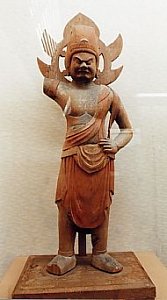
Zao Gongen
12th Century, Wood
One of oldest extant Zao pieces.
|
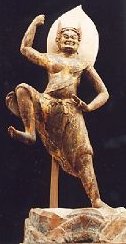
Zao Gongen
12th Century, Wood
at Nage-ire Dō, Mitokusan
|
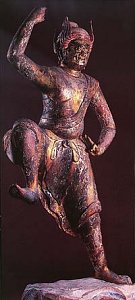
Zao Gongen. Dated to 1163.
Main Deity (Honzon 本尊)
at Nage-ire Dō, Mitokusan.
Yosegi-zukuri technique.
|
|

Notes on Zao Gongen
- NOTE 1. From Japan's mid-Heian period, Zao was also considered a manifestation of Miroku 弥勒. Says JAANUS: "In the mid-Heian period, when the cult of Miroku 弥勒 grew popular, Kimpusen came to be known as the inner sanctum of Miroku's paradise, Tosotsu Naiin 兜率内院, and Zao Gongen was considered a manifestation of Miroku. Zao Gongen was the guardian of Mt. Kimpusen, lit. "Gold Mountain," which was believed to contain gold treasure that would become accessible when Miroku appeared on earth. This was a major site of sutra burials, a practice said to have been introduced from China by the monk Ennin 円仁 in the 9th century. Copies of sutras were buried along with the donor's instructions for their future benefits. The sutras were expected to rise and bear witness to the religious devotion of the donor. The cult of Zao Gongen was carried throughout Japan along with the practices of mountain religion and there are many images of him, including small metal sculptures buried with sutras. The earliest dated image, 1001, is an engraved mirror owned by Sōjiji Temple 総持寺, Nishiaraidaishi 西新井大師, Tokyo. <source JAANUS>
- NOTE 2. Sometimes identified as a manifestation of Kongō Zaō Bosatsu 金剛蔵王菩薩, who appears in the Womb World Mandala (Taizōkai Mandara 胎蔵界曼荼羅) in the court of Kokūzō 虚空蔵. <source JAANUS>
- NOTE 3. Sometimes considered a manifestation of Kongōsatta 金剛薩埵 (Skt. = Vajrasattva, literally Vajra Hero). In Japan, the term is also applied to all Vajra Beings, or Vajra Bodhisattva, particularly those depicted in Japan's Diamond Mandala (Kongōkai Mandara 金剛界). Zao is also considered by some to be a Vidyaraja (Skt.), a group of wrathful Hindu deities adopted into the pantheon of Esoteric (Tantric) Buddhism to vanquish blind craving. In Japan, the Vidyaraja are known as the Myō-ō 明王 (literally "kings of magic knowledge" or "kings of light"). They assume wrathful appearances to frighten non-believers, to subdue evil forces, and to help devotees conquer their passions and desires. Nonetheless, Zao is mostly considered a Japanese invention, one who assumes Tantric forms and functions yet one who sprang from Japanese soil.
- NOTE 4. The whole mountain range from Yoshino to Kumano, the cradle of Shugendo, is considered the dual mandala of the Kongokai (Diamond Realm) and Taizokai (Matrix Realm). Kongokai represents the wisdom and efforts of Dainichi Buddha to destroy all illusion, while Taizokai symbolizes Dainichi's teachings. These two diagrammatic schemes of the cosmos are central to esoteric Buddhism. Zao Gongen is said to encompass both realms. <above paraphrased from Songs to Make the Dust Dance, The Ryojin Hisho of Twelfth-Century Japan, a wonderful study by Yung-Hee Kim that was released in 1994.

LEARN MORE
- Extended List of Gongen in Japan (this site)
- Zao Gongen Statues at our Sister eStore
- Holy Mt. Kimpu (Kinpu)
Kinpusen Temple web site (J)
- Kokugakuin University (Tokyo, Japan)
Gongen Shinko Belief System
About the Avatar Zao Gongen
- JAANUS (Japanese Architecture & Art Net Users System)
Zao Gongen Page
- PAGES BY GABI GREVE
Page One | Page Two | Page Three | Page Four
- PHOTOS & ARTWORK OF ZAO GONGEN
The Walters Art Museum, Baltimore, Maryland (E)
The Cleveland Museum of Art (E)
Osaka Municipal Museum of Art (E)
The Metropolitan Museum of Art, New York (E)
Treasures of Misasa Town, Tottori Prefecture, Japan (J)
More Treasures of Misasa Town, Tottori Prefecture, Japan (J)
Kimpusen-ji Temple's Zao-do Hall
- IMAGES OF VAJRASATTA
www.himalayanart.org/search/set.cfm?setID=154
- Yoshino & Omine Area -- Temples, Shrines, and Pilgrimages
www.sekaiisan-wakayama.jp/english/s_yosino.htm
www.pref.wakayama.lg.jp/sekaiisan/english/e-yosino_e.html
www.japanvisitor.com/index.php?cID=374&pID=786
- Shinto-Buddhist Syncretism
Songs to Make the Dust Dance
- Digital Dictionary of Buddhism
Entry on Mount Kinpu, Yoshina Area, Shugendo
- RELATED PAGES AT THIS SITE (A-to-Z Photo Dictionary)
Early Japanese Buddhism
Holy Mountains, Sacred Shrines of Japan
BUY STATUES ONLINE
- Buddhist-Artwork.com
Zao Gongen statues available for online purchase at our sister site,
along with 100+ statues of other major Japanese divinities.


|
|